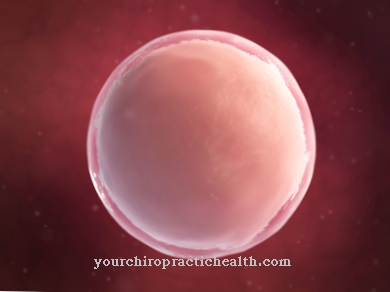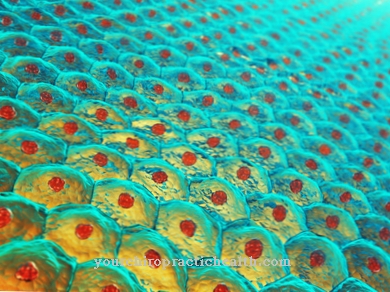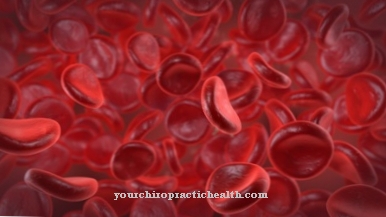The Phosphorylation is a fundamental process of biochemistry that takes place not only in the human organism, but in all living things with a cell nucleus and bacteria. It is an indispensable part of intracellular signal transduction and an important way of controlling cell behavior. Most of the time, components of proteins are phosphorylated, but other molecules such as sugar can also serve as substrates. From a chemical point of view, phosphorylation of proteins creates a phosphoric acid ester bond.
What is phosphorylation?

The term phosphorylation describes the transfer of phosphate groups to organic molecules - mostly these are the amino acid residues that make up proteins. The phosphates have a tetrahedral structure made up of a central phosphorus atom and four surrounding, covalently bound oxygen atoms.
Phosphate groups have a double negative charge. They are transferred to an organic molecule by specific enzymes, so-called kinases. With the consumption of energy, these usually bind the phosphate residue to a hydroxyl group of a protein, so that a phosphoric acid ester is formed. However, this process is reversible, i.e. it can be reversed, again by certain enzymes. Such enzymes that split off phosphate groups are generally referred to as phosphatases.
Both the kinases and the phosphatases each represent their own enzyme class, which can be subdivided into further subclasses according to various criteria such as the type of substrate or the mechanism of activation.
Function & task
A crucial role of phosphates, especially polyphosphates, in the organism is the supply of energy. The most prominent example of this is ATP (adenosine triphosphate), which is the main energy carrier in the body. Energy storage in the human organism therefore usually means the synthesis of ATP.
To do this, a phosphate residue has to be transferred to an ADP (adenosine diphosphate) molecule so that its chain of phosphate groups, which are linked via phosphoric anhydride bonds, is extended. The resulting molecule is called ATP (adenosine triphosphate). The energy stored in this way is obtained from the renewed cleavage of the bond, leaving ADP behind. A further phosphate can also be split off, whereby AMP (adenosine monophosphate) is formed. Each time a phosphate is split off, the cell has more than 30 kJ per mole available.
Sugar is also phosphorylated in the course of human carbohydrate metabolism for energetic reasons. One also speaks of a "collection phase" and a "recovery phase" of glycolysis, since energy in the form of phosphate groups must first be invested in the starting materials in order to obtain ATP later. In addition, glucose, for example as glucose-6-phosphate, can no longer diffuse unhindered through the cell membrane and is therefore fixed inside the cell, where it is required for other important metabolic steps.
In addition, phosphorylations and their reverse reactions, in addition to allosteric and competitive inhibition, represent the decisive mechanisms for regulating cell activity. In most cases, proteins are phosphorylated or dephosphorylated. The amino acids serine, threonine and tyrosine contained in proteins are modified most frequently, with serine being involved in the overwhelming majority of phosphorylations. In the case of proteins with enzyme activity, both processes can lead to activation as well as inactivation, depending on the structure of the molecule.
Alternatively, the (de) phosphorylation by transferring or removing a double negative charge can also lead to the conformation of the protein changing in such a way that certain other molecules can bind to the affected protein domains or no longer. An example of this mechanism is the class of G-protein coupled receptors.
Both mechanisms play an outstanding role in the transmission of signals within the cell and in the regulation of cell metabolism. They can influence the behavior of a cell either directly via the enzyme activity or indirectly via altered transcription and translation of the DNA.
Illnesses & ailments
As universal and fundamental as the functions of phosphorylations, the consequences if this reaction mechanism is disturbed are just as varied. A defect or an inhibition of phosphorylation, usually triggered by a lack of protein kinases or their deficiency, can lead to metabolic diseases, diseases of the nervous system and muscles or individual organ damage. Nerve and muscle cells are often affected first, which is manifested in neurological symptoms and muscle weakness.
To a small extent, some disorders of the kinases or phosphatases can be compensated for by the body, as there are sometimes several ways of forwarding a signal and thus the "defective point" in the signal chain can be bypassed. Then, for example, another protein replaces the defective one. A reduced efficiency of the enzymes, on the other hand, can be compensated by simply increasing production.
Internal and external toxins as well as genetic mutations are possible causes of a deficiency or malfunction of kinases and phosphatases.
If such a mutation takes place in the DNA of the mitochondria, there are negative effects on oxidative phosphorylation and thus ATP synthesis, the main task of these cell organelles. Such a mitochondrial disease is, for example, LHON (Leber hereditary optic neuropathy), in which there is a rapid loss of vision, sometimes in combination with cardiac arrhythmias. This disease is inherited maternally, i.e. exclusively from the mother, since only her mitochondrial DNA is passed on to the child, but not that of the father.




























.jpg)